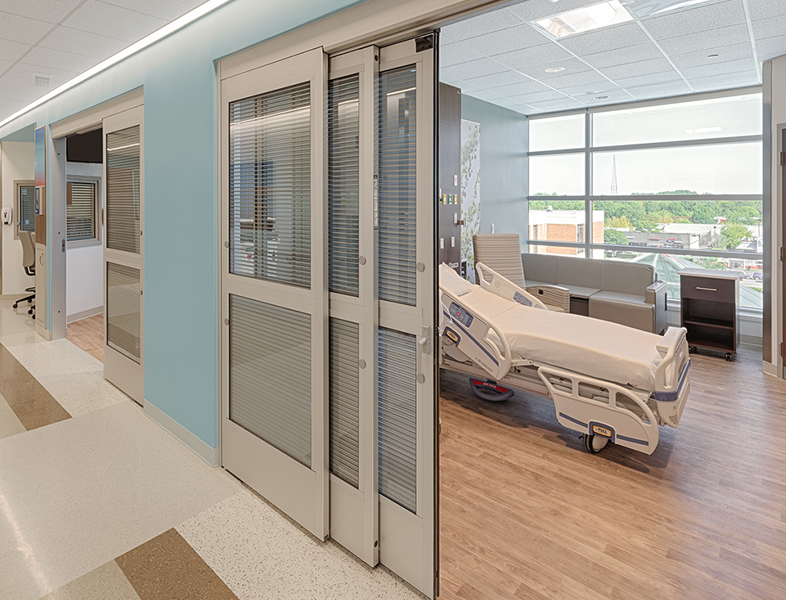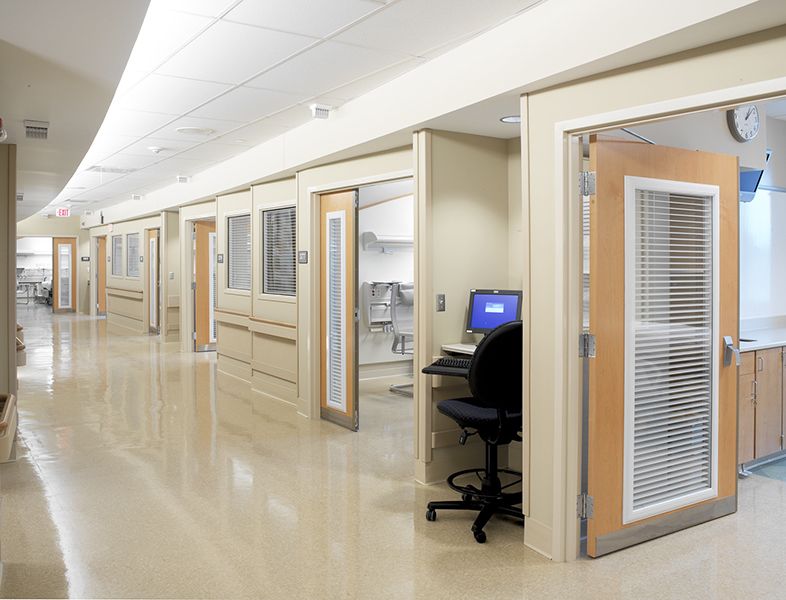Fire-rated glass and glazing has been an indispensable safety component within the built environment for decades. It’s used in both interior and exterior applications to help contain the spread of fire, and can be installed in doors, walls, windows, and even floors; it’s often found in corridors, stairwells, lobbies, courtyards, and wall partitions.
But today’s fire-rated glass certainly isn’t the same institutional-looking wire mesh of yesterday.
Indeed, modern fire-rated glass has evolved significantly from traditional and relatively unsafe wired fire safety glass. New types of fire-rated glazing products – including insulating glass units (IGUs), glass ceramics, intumescent glass, and fire-rated steel framing systems – can withstand impacts, provide acoustic insulation, and even contribute to LEED certification in the categories of energy & atmosphere and materials & resources.
But perhaps most refreshingly, modern fire-rated glazing can now also make a positive contribution to interior and exterior aesthetics – allowing designers to create open, bright, welcoming spaces in areas that also need fire protection.
There are two main types of fire-rated glazing: fire-protective glass and fire-resistant glass:
- Fire-protective glass is designed to retard the spread of smoke and flames from one building compartment to another
- Fire-resistant glass protects further by blocking conductive and radiant heat, and is subject to more stringent testing standards (we’ll discuss fire-rated glazing testing standards a little later in this post)
Which type of fire-rated glazing is used typically depends on job requirements and applicable building codes, including the International Building Code (IBC), which governs fire-resistant glass applications in the U.S.
While standard window glass typically breaks at around 250 degrees Fahrenheit, modern fire-rated glass can live through temperatures exceeding 1,600 degrees Fahrenheit. Fire ratings for glass typically reflect the time increment the product can withstand a fire according to testing – so if the glass has a 20-minute fire rating, that means it can withstand fire for 20 minutes.
What types of fire-rated glass are there?
Fire-rated glass has come a long way since the days of mandated mesh wire glass. Formerly a building code requirement, revisions to the IBC in 2003 and 2006 removed the need for wire mesh glass in all types of building construction. That, in turn, opened the door for architects and building materials specifiers to begin incorporating new types of fire-rated glazing systems in their designs.
Relatively new types of fire-rated glazing systems now being used in construction include:
IGUs
Fire-rated insulating glass units include fire-protective or resistant glass and framing systems that do much more than stop or slow the spread of fire. Modern IGUs can be custom built to suit any exterior or interior application, and help conserve energy by reducing solar heat gain, improve acoustic control, and improve natural daylight within a space.
When fire-rated IGUs are outfitted with cordless louvers between hermetically sealed glass, they also provide a completely adjustable privacy and visibility solution requiring no maintenance. IGUs can be outfitted with modern fire-rated glass including glass-ceramics or intumescents.
Glass Ceramics
Also known as ceramic glass, glass-ceramics can withstand sudden and repeated temperature changes up to 1,000 degrees Celsius, allowing it to be used in glazing systems with fire ratings of up to three hours in some cases. Ceramic glass is made by crystallizing a normal glass pane through a treatment of intense heat. It’s relatively versatile, being used in both windows and doors as well as glass cooktops or fireplaces.
The downside to many glass-ceramic products, however, is that they do not block radiant and conductive heat.
Intumescent glass
This is laminated glass composed of multiple, alternative layers of glass and clear intumescent sheets. Like glass-ceramics, it can also be fire rated up to three hours. Intumescent glassworks by allowing the outer glass layer to shatter during a fire, with the inner intumescent layers then expanding with the heat to provide a strong barrier to smoke, flames, and radiant/conductive heat.
Fire-rated framing systems
Modern fire-rated glass typically comes as part of a system, or assembly, including window or door framing that has earned the same fire rating. This is another big improvement on traditional fire-rated glass, which was typically accompanied by bulky hollow metal framing with exposed fasteners. New fire-rated steel framing includes narrow-mullion profiles, covered caps, surface finishes to match their surroundings, and “well-defined corners and crisp edges to ensure smooth visual integration with non-rated assemblies.”
Fire-rated glazing systems can now also be combined with impact-resistant glazing for a far safer product than traditional wired glass (which is prone to breaking, and can be very dangerous once broken due to the wires creating a more jagged surface).
How does a glazing system receive a fire rating?
As mentioned previously, fire ratings are typically represented by the number of minutes the glazing system has been certified to block smoke and flames (and radiant heat, in some cases). Fire-rated glass is typically certified by safety certification companies such as Underwriters Laboratories (UL LLC).
But how do these assemblies receive a fire rating in the first place?
Fire ratings are determined by running a (sometimes two-part) test, with the first phase involving a furnace to simulate the intense heat of a burning building. To pass this test the glass must stay together within its frame (some cracking is allowed, as long as the glass stays intact and continues to block the fire) for as many minutes the certification requires.
The second part of a fire-rating test, for any glass in the U.S. looking for a 45-plus minute certification, is the hose stream test. This test applies a heavy stream of water to the already-hot glass – from 20 feet away and with a force of 57.7 lbf at 30 psi, and 86.6 lbf at 45 psi – to ensure it can withstand such pressure without shattering.
Fire-rated window standards in the U.S. are governed by the National Fire Protection Association, including standards such as NFPA 257 (windows) and NFPA 252 (doors).
How do modern fire-rated glass assemblies contribute to better building design?
We’ve already mentioned several ways in which modern fire-rated glazing assemblies improve upon their wire mesh predecessors from a design sense:
- Clear, lustrous fire-rated glass allows more flexibility to open up and brighten interior spaces, without having to use institutional-looking wired glass
- That means architects can use glass as fire barriers instead of less design-friendly and opaque materials such as steel or concrete
- Fire-rated framing systems with lower profiles and other design considerations have dramatically improved their overall aesthetics, allowing greater design flexibility
Other building code changes over the years have improved the design features of fire-rated glazing systems, including the ability to install larger sized panes of glass. While building codes previously limited the size of 45-minute fire-rated wired glass to nine square feet, designers today can work with fire-rated glass that’s 40 square feet or larger. That’s largely due to the emergence of those better, higher-performing materials we discussed earlier.
An example of fire-rated glass being used to great effect from a design perspective (on the exterior) include the 32-floor Sapphire Towers in San Diego, which was required to use 45-minute fire-rated glazing on its south side. This simply would not have been possible using traditional wire glass.
Turn your design dreams into reality with versatile and practical fire-rated glass
Unicel Architectural offers several UL-listed fire-rated glazing systems at 20, 45, 60, and 90 minutes for doors, windows, transoms, and sidelights, including its most recent certification of 45 minutes (including the hose-stream test) for door applications. Our custom manufactured steel trim kits combine with Pilkington Pyrostop® fire-rated glazing, which can be further combined with any of our Vision Control®, Vision Control Mini®, and ViuLite® products.
Pilkington Pyrostop is clear, laminated fire safety glass that turns opaque during a fire, providing a strong barrier to flames, hot gases, and radiant/conductive heat.
Want to learn more about how Vision Control integrated louvers help meet these and other challenges head-on in institutional and mental and behavioral health facility design? Contact us today to learn more.
News and Updates
The latest from Unicel Architectural

Smart Security Hardware: Why Your Next Window May Have Situational Awareness
- Blog, Innovation
Vision Control® Mini in Doors
Product Spotlight - Blog, Product Spotlight


